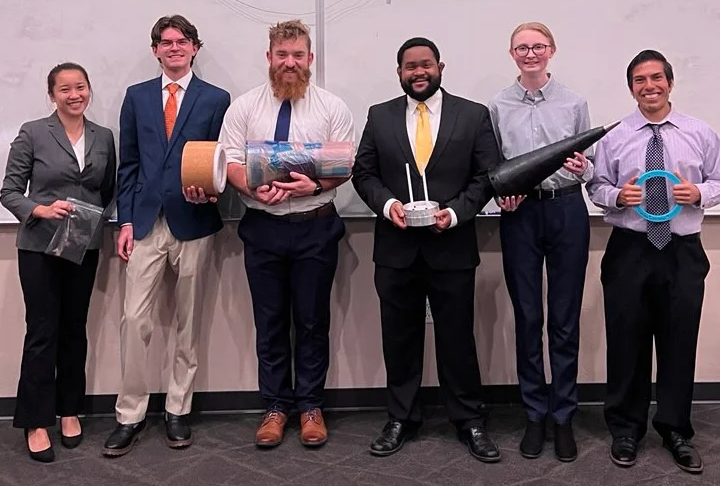Engineering Seniors Display Work in Fall 2023 Capstone Design Symposium

Each semester, senior engineering students participate in an academic rite-of-passage: the opportunity to apply their classroom learning to a real-world project and to present that project to the Prescott Campus. Known as the Senior Design Symposium, the event is a perfect example of the creativity, curiosity and aptitude for problem-solving that define Embry-Riddle engineering students.
29 teams from Aerospace Engineering and Mechanical Engineering showcased their work during the December 2023 symposium. While some groups partnered with industry contacts to solve business challenges, others opted to address NASA-issued prompts or to solve problems specific to the Prescott region.
For Dr. Dietmar Rempfer, dean of the College of Engineering, the December symposium was a meaningful first during his time at Embry-Riddle. “Our students have once again shown why Embry-Riddle engineering graduates stand out in their field,” he said. “Their extraordinary creativity, coupled with the ability to envision, pursue and then realize impactful solutions to complex engineering challenges, stands as a defining characteristic of the future engineers emerging from our campus. Experiencing this showcase of their projects for the first time as the new Dean of Engineering, I was as impressed as I was proud of our students.”
Individuals who attended the Senior Design Symposium were asked to vote for their top three projects, with a total of 116 votes cast. Team TIPSY, who developed a control moment gyroscope testbed for use in Embry-Riddle’s Spacecraft Attitude Dynamics and Controls class, led the pack. Peter Villalon headed a team that included Michael Cline, Samantha Greene, Alexander Service, Dominic Stringer, Connor Wilmers, Haley Wood and Kira Wood as its members. Dr. Katherine Wood and Dr. Matthew Haslam provided faculty guidance.
Team Imhotep, led by Hope Elmer, took second place. Imhotep designed, built, and tested an upper-body structure for integration on the Eagle Space Flight Team’s rocket. Imhotep, which includes Caleb Hernandez, Meleik Lewishall, Ben Malone, Gabe Moore and Rita Tagarao, hopes to pass the Karman line.
“One of the most challenging and rewarding aspects of our project was ensuring the structure will survive the high surface temperatures (~1600K) present on its trajectory to space. The structural materials (composites and aluminum) have melting temperatures below the maximum temperatures, so an ablative is required to protect the structural walls. We chose to use cork because of the low financial cost; however, the thermal properties of cork are not fully characterized so no accurate preliminary calculations could be completed to give confidence in our design,” the team said. “During the detail design of our project, we were able to manufacture test specimens and verify the cork ablative will satisfy the requirements. During the verification test, an acetylene torch was used to simulate elevated temperatures, and the cork performed exceptionally well with the maximum internal wall temperature recorded to be 325K. We went into the design semester of our capstone with little to no confidence in surviving the expected temperatures, to now having a verified system that can exceed the expected flight temperatures while remaining structurally sound.”
Like Team Tipsy, Imhotep was advised by Dr. Katherine Wood and Dr. Matthew Haslam.
“The most rewarding part of my academic year is watching my capstone students present their final project, especially knowing how much of their blood, sweat and tears (often literally) went into their projects,” Dr. Wood said. “The growth I observe from their first presentation in Prelim to their last in Detail is often astounding and I am grateful for the opportunity to be part of that journey.”
COSMOCRATE (or Cargo Optimization System for Modular Orbital Containers, Reusable for Atmospheric Environments) secured third place. Team COSMOCRATE created a modular cargo transport system for use in deep space missions. The team was led by Jarrod Alec Schwab and included Chloe Noelle Cornelius, Kevin Martin Dors, Ivan Alexander Filuk, Adam Maximillian Moore, Jackson Kincaid Steiner, Boniface Thuranira and Brian Andrew Zelt. Dr. Ron Madler, Professor Mark Benton and Dr. Richard Mangum provided faculty guidance.
The team shared, “The most rewarding aspect of the project has been seeing the progression from the initial proposal to our current design. The advancement from concept discussions to holding 3D printed models that demonstrate functionalities is very gratifying. One of the most important lessons our team learned is the importance of consulting with the machine shop faculty early in the design process. Communication with the fabrication faculty provided vital information that ensured our designs were feasible to manufacture. This early and often communication allowed for ample time to make adjustments based on the received feedback rather than a complete redesign later on in the design process.”
Faculty advisor Dr. Madler said, “The symposium is a great event for all the engineering students to see what kinds of solutions our seniors have found for interesting problems. The seniors do a great job of presenting their work and also discussing their project during the poster sessions.”
Professor Benton added, “Capstone projects provide our senior engineering students with opportunities to develop technical, innovative and project management skills in a challenging curriculum focused on solving complex, real-world engineering problems in a time-constrained schedule. They present the results of their projects in a rigorous technical symposium attended by engineering industry representatives and faculty. Their significant experiences in the capstone course prepare them for success in their engineering careers.”
